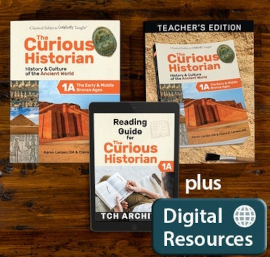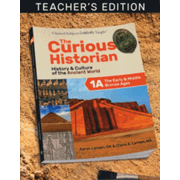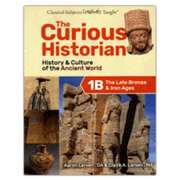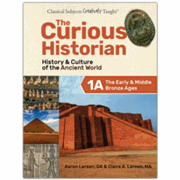The Curious Historian is a three-year history program for students in grades five through eight. The first course can be started in fifth grade or above, and the courses progressively get more difficult. The program is designed as a series of one-semester courses that present world history in chronological order. Students will complete two courses per year. The courses are:
- 1A: The Early & Middle Bronze Ages
- 1B: The Late Bronze & Iron Ages
- 2A: Greece and the Classical World
- 2B: Rome and the Classical World
- 3A: The Early Middle Ages
- 3B: The Late Middle Ages
Keep in mind that students might need to complete a United States history course and/or a state history course sometime between grades five and eight, and this might affect the sequence in which you complete these courses. You might also be able to work through three courses in one year with students in junior high.
Course Components
The essential components for each course are the student edition and the teacher’s edition. Both books have soft covers and are printed in full color with plenty of images, maps, and charts.
Free resources that enhance or support each course are available on the publisher’s website. These include schedules, quizzes, answer keys, song lyrics, and a “Go Deeper Resources” PDF, such as Go Deeper Resources PDF for 1A. You can also purchase the optional digital TCH (The Curious Historian) Archive: Extra Resources for each course that I describe below.
The Educational Approach
The Curious Historian is a classical curriculum, but unlike many classical programs, it encourages students at these levels to begin thinking like historians rather than primarily focusing on memorizing names, places, events, and dates. To that end, the student edition points out the sometimes-conflicting interpretations of historical artifacts or events. It raises questions about the causes and significance of events, and it teaches students to compare and evaluate what they are learning.
Since the courses’ authors believe that a primary reason for studying history is to cultivate virtue and wisdom, they also help students learn to evaluate actions as praiseworthy or blameworthy—students learn that most people exhibit both types of actions. (This feature is more apparent in the courses for the time periods where we know more personal information about people than we do for those from ancient history.)
Even though the Curious Historian courses do not rely heavily on memorization like many classical approach courses, students still learn facts about key people and events. Each chapter usually opens with terms, people, and key events. The teacher should go over the pronunciations, definitions, and descriptions before starting to read the chapter aloud with students. Quizzes test students on that information. Songs for each course also summarize key information and set it to music to make it easier for students to remember.
The courses are designed to be used interactively. The text is to be read aloud with pauses to discuss the optional sidebars that have related historical information, historical connections to the Bible, words derived from Greek and Latin, maps, and discussion questions. (Students who are already studying Latin or Greek might find the discussions about word roots especially helpful.) The discussion questions are often quite interesting, such as one on page 22 that asks, “How important is the wheel?” Some discussion questions are more personal, such as the one on page 134 that asks, “Do you know what your name means and why it was chosen?”
The Curious Historian series is secular in its approach, even though it discusses the beliefs of various religions and makes some connections to biblical history. For example, on page 101 a sidebar says, “One part of the Epic of Gilgamesh includes a story of a great flood that sounds very much like the account of Noah’s flood in the Bible.” Christian families might want to add religious content by using the Biblical Connections from the Extra Resources (described below) to ensure that students learn where biblical events fit within the study of history or to learn about such things as how Hammurabi’s Code compared to Mosaic law.
Teachers might also want to use the free Go Deeper PDF that has extra information that is worth perusing. The PDF contains some information itself, but most of it consists of links to websites with videos, articles, and images.
The teacher’s editions have the complete student text with overprinted answers plus many sidenotes and footnotes with additional information and suggestions for further learning. The teacher’s editions also suggest reading stories from Susan Wise Bauer’s Story of the World series, and the pertinent stories are referenced in sidenotes.
Student editions include an extensive set of exercises at the end of each chapter, many of which are identified as being optional. The exercises always include two sections titled “Talk It Over” (that presents an interesting question for discussion) and “Think About It” (a deeper thinking question for either a written answer or discussion). There are also various content review exercises with different types of questions: multiple choice, true/false, short answer, fill in the blanks, matching columns, completing charts, listing key facts, and more. “Be Creative” exercises offer students opportunities for creative writing based on what they are learning. Map exercises have maps to be labeled. Finally, there are occasional activities with puzzles, drawing, crafts, and games.
Each unit concludes with a review chapter which has a brief summary of key ideas and quite a few exercises that review the unit’s content. Review chapters also feature a story about a child that takes place within the time period of the unit and helps students understand what life was like. In addition, there is an End-of-Book Review that goes back over the entire course with a brief summary and many exercises.
If you want to test students, an appendix has a one-page quiz for each chapter. The quizzes are also available as free downloads on the publisher’s website. Answer keys for the tests are in an appendix of the teacher’s edition.
TCH Archive: Extra Resources
The Extra Resources are optional, but you might find these digital resources very useful. I will describe those for the first course, but those for the other two courses are similar.
Each course has three or four lengthy songs that help students remember key points. Two or three of the songs are tied to the two or three units of the course, and students learn stanzas of the songs gradually as they move through each unit. The final song is “Top 12 Things to Remember from TCH1A,” with the last number and letter changing to identify the course. Students can listen to the songs (MP3 files) on various devices. Words to the songs are printed in an appendix in both the student and teacher books. An attractive, printable PDF also has the words for “Top 12 Things to Remember.”
A PDF titled Biblical Connections can be used by the teacher to connect biblical history, biblical geography, and Bible verses to the study of history. Occasionally, there is a question to discuss or a personal application to consider. The teacher’s edition has icons alerting the teacher as to when to use this.
A PDF Reading Guide has a supplemental reading list with recommendations for both students and teachers.
Some resources duplicate material already in the books, but the digital format makes it easy to print out these pages. These include blank maps, a course timeline with illustrations, timeline tables with information printed in charts, and a “Reference Archive” with charts summarizing key information, such as the most important deities of a culture and the Mesopotamian eras of government (e.g., Sumerian Archaic Period, Akkadian Empire, etc.).
Free samples from most of the resources, including the songs, are available by clicking on “Look Inside” on the product pages.
Summary
Many families will appreciate the way The Curious Historian series helps children approach history in the manner of historians rather than simply as information to be memorized.
The flexibility of the courses is another valuable feature. The text within the student edition can be read relatively quickly, but using the discussion questions and some of the extra activities as you read through the text can expand each course’s content significantly. Many other course components, such as tests and map work, can be used at the discretion of parents as well. All of these options give families the ability to tailor lessons to fit their time schedules and to select learning activities most beneficial for them.














